According to the Fars Metrological Department, in 1999 the northern parts of the province of Fars received about half of the long-term average annual precipitation. In the central parts of the province there was 80-90% less precipitation than normal and in the southern parts 100% less than normal. The average annual rainfall for the entire province is 300 mm. During the drought, the average temperature was 1-2 degrees centigrade greater than the long-term average during the spring and summer, and during autumn and winter about 0-1 degrees centigrade greater.
In 2000 most areas of the province received more precipitation than the year before, but still only about 50-70% of their long-term annual average. In 1380 (2001) the average annual rainfall for Eqlid (located in the summering grounds of the Koohi) was 444.3 mm and for Firoozabad (located near their wintering grounds) it was 104.5 mm.
The total annual precipitation for 5 rainfall stations in the province of Fars for 1961-2000 is presented in Annex 3. The following tables from the Iran Meteorological Organisation show various precipitation patterns for the province.
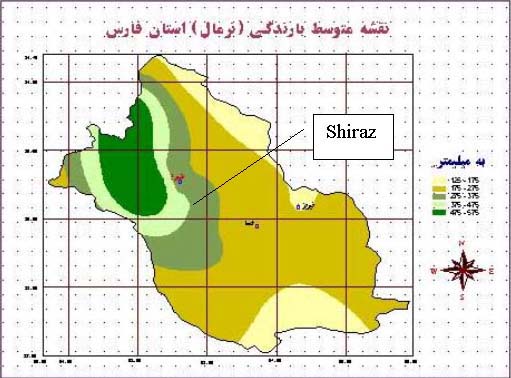
Figure 3 Average annual normal precipitation levels (mm)
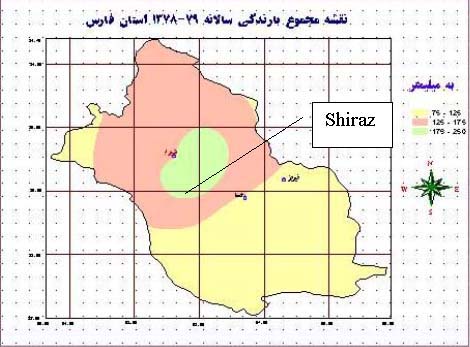
Figure 4 Annual rainfall in Fars Province, 1999-2000 (mm)
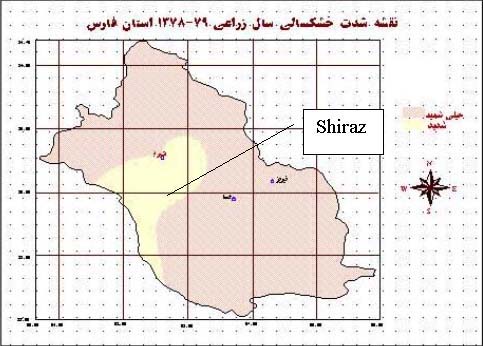
Figure 5 Severity of drought in Fars, 1999-2000 (pink area: very severe drought; orange:severe drought)
Most of the information in this section is drawn from a workshop held with the Koohi Sub-tribe in their summering grounds near Eqlid in the summer of 2003. The workshop was held in Turkish, the language of the Qashqai. About 50 members of the Sub-tribe participated in the discussion, including all members of the Council of the Sub-tribe of Koohi Migratory Nomads for Sustainable Livelihoods. Supplementary information was gathered through smaller group interviews with members of the Council and some written sources.
The Koohi reported that they had lived through droughts of varying degrees of severity every 4 to 11 years for the past 40 years. However although they were clearly no strangers to drought, they emphasised that the frequency, severity and particularly the impact of drought on their livelihoods had been increasing over this period.
Drought is one of the most important determinants of the quality of life for nomads. As with all droughts the drought of 1999-2001 essentially served to intensify the pressures that pastoralists face even in non-drought years. Currently, the most important pressures they face are: coping with less land and living with greater costs. It is clear that their main problem is access to grazing land and this is not exclusive to drought years.
The entire Sub-tribe now has only 35,000 heads of livestock and we are under continuing pressure to sell them. My father had 1,500 sheep and I only have 300 left. The land that we have is not even enough to sustain this reduced number because farmers are continuously taking our land.
We don’t have enough land and so are forced to sell our animals.
Drought leads to a downward spiral of debt and poverty culminating in the most extreme cases in the sale of a family’s entire herd (the source of pastoralists’ wealth) at low prices and their permanent settlement in villages and towns. According to their own rough estimates, on average about 10% of the Koohi settle in villages, towns and cities each year, however they stress that in some years there is no sedentarisation.
In drought years the supply of animals goes up and demand goes down so we are forced to sell a sheep for a fifth or sixth of the price that we know it is worth.
Another cost burden is the cost of fodder. As their access to rangelands becomes more limited, and the available land is increasingly degraded, pastoralists are forced to buy fodder for their animals. During the drought, in some cases the Koohi bought fodder in the summering grounds and transported them to the wintering grounds by truck, otherwise they would have been forced to buy fodder from merchants in Farashband (a town near the wintering grounds) at high prices. The most important fodder that they purchase is barley but alfalfa, corn, by-product of turnip sugar factories, hay (from beans, chick peas and lentils) are also important. Lastly there is some use of a concentrated feed which is made from a mix of corn and chemical fertiliser.
Buying fodder and renting land are our two greatest costs. We have to borrow money to buy the fodder and then when it’s time to repay we have to pay interest and we get stuck in a loop of debt. We are then forced to take our children out of school.
The situation is not the same for all Sub-tribe members because grazing permits are granted on an individual basis and individual circumstances differ. The situation seems to be worse in the wintering grounds than the summering grounds. On average, about 50% of the Qashqai do not have grazing permits for wintering grounds.
The most vulnerable people are those who do not have grazing permits for the wintering grounds because they have to pay rent for land and buy fodder.
Therefore drought leads to increased cost (especially fodder) and decreased revenues (because of falling livestock prices) so it pushes pastoralists further towards debt. The drought - or any other external pressure - simply intensifies existing burdens. The most extreme impact on livelihoods is sedentarisation: permanently abandoning pastoral livelihoods for other livelihood systems such as farming or trading. Sedentarisation is a much more common result of drought than it used to be (see section on the historical comparison of the drought management cycle, below, for more details). In some cases families become sedentary temporarily during the drought when there is not enough water and vegetation and then they begin migrating again when the drought is over.
When asked how some members managed to continue migrating despite the droughts and other pressures they responded, “We are taking our last breaths”. Some say that they have stayed because they don’t know how to live any other way, but making ends meet is difficult.
Those that have continued migrating are mostly in debt. Even if they wanted to, they could not repay their loans to the bank.
A few pastoralists (mostly the youth) are even forced into illegal but more lucrative lines of work such as trafficking. In some cases pastoralists cut back on their own food to buy fodder for their animals.
Social and cultural reasons are also impacting to decrease the numbers of pastoralists who continue to migrate and make their living from herding livestock.
The younger generation have gone to school and are literate. They are no longer willing to make their livelihood as pastoralists. It’s clear that the number of migrating pastoralists will continue to decrease.
Finally, the drought acts to increase conflict in the community: people are forced to compete even more than usual for scarce resources and this leads to conflict. There are no incentives for cooperation because rewards and punishments are handed down to individuals and not the community as a whole.
The organisations that pastoralists have turned to for support in recent years are governmental or para-governmental organisations. Most important among these are FARO and ONPA. Other organisations such as the Disaster Task Force and IRCS were basically unknown to them. None of these organisations is seen to be giving even the minimum of support they need. Their two main complaints against the government were their pro-sedentary policies and allegations of corruption.
One of the main forms of support for rural communities after a natural disaster is government loans but pastoralists themselves say that the loan schemes are riddled with corruption and are also very bureaucratic. It is clear that with the current limitations pastoralists do not see these loans as a viable solution.
After the recent drought, the Majlis [parliament] approved banks loans for farmers and pastoralists, but the loans were only received by people with connections and influence.
If there are any loans to be had, the head of the Ministry of Agriculture and Rural Development announces it to the rural communities and farmers. If the loans are specifically for pastoralists then the rural folk bribe someone in the loan office, then they find someone with a grazing permit to use his license to get the loan. They pay both parties off to get the loan. In fact, unless civil servants receive a bribe they don’t do anything! No one has ever received a loan without handing out a bribe.
We know that the government gives grants to each province for pastoralists. But instead of pastoralists receiving the funds directly, it’s the ONPA that receives those grants. I don’t know how they spend them.
The government doesn’t really help and even if they offer a small loan this usually involves a very bureaucratic process.
Corruption was also mentioned in relation to state provisions of fodder. Pastoralists questioned why fodder provided by the government was being sold to them at market prices: if fodder merchants were making a profit at market prices then why was the government selling fodder at for-profit market prices and furthermore, what was it doing with that profit?
The government was offering us fodder at the same price as the fodder merchants - so there is no difference between the government and a business! We prefer to buy from the merchants because it is a much simpler process. Even if we have to pay back in instalments with an interest rate we prefer to do business with the merchants.
The pastoralists’ cooperatives[4] are another organisation that could help during disasters, but they were also accused of corruption. There is a clear lack of trust in the cooperatives- whether in drought or non-drought years. They say that the cooperatives essentially act as profit-making businesses.
The cooperatives don’t do anything special during a drought. The only thing they usually do for us is to sell the subsidised supplies that we are all entitled to according to the government’s ration system. On the one hand we’re happy to receive subsidised sugar and flour, but on the other we don’t know what they are doing with the profits of the cooperative. The cooperatives are just like any other business - they make a profit for themselves - the only difference is that their goods are more expensive than the regular shops. The cooperative sells a tent for 2.8 million rials that you can buy in a regular shop for 800,000 rials. They sell barley that is normally 1,000 rials per kilo for 1,800 rials. We’re forced to buy from the cooperative because it allows us to pay in instalments and we don’t have enough money to pay in one instalment.
With respect to specific emergency-related government interventions, the pastoralists had less direct experience of government programmes. They had never heard of the Disaster Task Force and when asked about non-financial support they mentioned the activities of the Red Crescent, but also spoke of corruption.
I remember there was a storm a few years ago and the Red Crescent Society brought some tents - supposedly for us. Well, the trucks never reached us - they stopped in Farashband and the tents were sold there for 2 million rials each.
To understand the action taken by government organisations during a drought it is important to understand how they support pastoralists in general during non-drought years. The members of the Sub-tribe see the government as essentially working against them, favouring settled communities - especially farmers - and adopting policies that directly or indirectly lead them to sedentarisation themselves. They see FARO as their main antagonist and the ONPA as being too weak to support them.
FARO wants to destroy us. They don’t even try to cover it up. They want to take all our lands from us. Pastoralists have no supporters.
No one gives us any answers- not the police, not the judiciary, not our members of parliament. The people who we rely on for help are usually on the side of the villagers or come from the villages themselves so we are always losing.
Who is responsible? No one accepts responsibility for pastoralists. So far, no one has been concerned about them. The organisation that is supposed to be responsible for pastoralists is the ONPA but it doesn’t have enough power. It has to do whatever the Ministry of Agriculture orders it to do. There is not one single independent supporter of the entire pastoralist populations of Iran.
The government is widely criticized by pastoralists as taking every opportunity to appropriate their last remaining lands for agriculture by settled rural communities.
To sum it up: there is no such thing as help or support for pastoralists because of drought or other natural disasters. I don’t know - maybe they help other tribes and not ours - but I would warrant that other tribes are worse off than we are. I think all the relief must be geared towards the farmers. This is a fact.
They also say the government supports farmers in other ways without extending the same support to them.
Farmers have a guaranteed price for their crops [the government guarantees prices on certain key crops for farmers] but we don’t have guaranteed prices for our livestock - even though we are important livestock producers in this country.
Traditional knowledge related to drought management is part of the vast body of traditional knowledge related to natural resource management. The development and application of this knowledge relied heavily on the social organisation of the tribes with each member playing a role according to their position in the pastoral organisation.
Pastoralists divide their traditional drought-related activities into two main groups: activities before the disaster and activities after the disaster (roughly comparable to preparedness and relief and rehabilitation). Preparedness activities were led by a variety of mechanisms for drought prediction. Drought was predicted in a number of ways. The most common early warning system was based on observation of weather patterns.
Usually around the first of Esfand [21 February] you can tell whether the year will bring a drought. It’s just like the saying, “saali ke nekoost az bahaarash peydast” [a good year is heralded by a good spring].
In addition to this simple prediction, the sub-tribes would send scouts (peeshgharaavol) to the ranges about 20 days before the planned day of the migration. These scouts were experts at assessing the condition of the grazing lands and would bring back news that allowed the tribe to adjust the date or duration of the migration if necessary to avoid the harshest impact of the drought- by delaying the date of migration or extending the time spent on the migratory routes pastoralists could decrease the amount of time they would stay in the wintering grounds and therefore ease their impact on the drought-stricken wintering grounds (droughts were more common in wintering than in summering grounds). Furthermore, even in non-drought years an early arrival at the wintering grounds would risk consumption of the vegetation before it had begun to seed. The scouts would also clearly stake out the grazing area of each tenthold in advance of their arrival in order to avoid conflicts later when they all arrived together. Scouting was therefore important in both drought and non-drought years by enabling pastoralists to estimate the best time to arrive at the grazing lands.
One sub-tribe of the Qashqai Tribal Confederation, the Hoolegooh, who were known as monnajem (astronomers), were specialists in predicting the chances and duration of drought. They used their knowledge of vegetation patterns, wind patterns and cloud patterns to predict rainfall and drought. This allowed them to prepare themselves well in advance for any drought.
Some of them are so expert that in the autumn they can predict a drought in the following year. They can even predict the time of rain during the day. They figure this out from the direction and patterns of the wind. For instance, based on the way the wind is blowing now they will tell you whether there will be rain in 5 months time.
Emadi has detailed indigenous knowledge of rainfall patterns and preparation for drought among another branch of the Qashqai Tribal Confederation, the Ghareghani clan of the Ghareghanli sub-tribe which is a part of the Dare-Shori tribe.
The knowledge and ability of nomads to predict drought and rain is reflected in the time spent observing and categorising the climate (winds, cloud, temperature and moisture), nature (flora and fauna), animal behaviour (seasonal bird migration, domestic animal behaviour) and also astrological coincidence. For instance, rain is classified in different ways according to its style, season and intensity.
The Ghareghani nomads are aware of the main characteristics of rainfall, and classify rainfall in different ways according to style, density, season, and associated events (thunder, lightning and storms etc.). The second important aspect of their awareness is their sophisticated definition for an optimum rainfall of pasture and farming in each particular situation. The third important aspect is that they change grazing routes and patterns according to rainfall.
In terms of the impact of the rainfall, Ghareghani say that rainfall has positive as well as negative impacts on both pasture and animal husbandry, but the best pattern is for rainfall to continue from middle autumn to late spring in the winter quarter, with enough snow in the summer quarter for the enrichment of natural springs.
If a drought was predicted then pastoralists would try to avoid a heavy impact on their own livelihoods and on the environment by making adjustments in the timing and duration of their migration as indicated above. First, they would adjust the timing of the migration (in most cases it was the migration from the summering to wintering grounds that was affected because drought has been more common in the wintering grounds). In order to avoid facing drought pastoralists would start their migration later and thus spend less time than usual in the wintering grounds. Second, they would extend the duration of migration, also to arrive at the wintering grounds later. This enabled them to take advantage of the relatively good vegetation in the high mountains of the migration route and also arrive later at the drought-stricken wintering grounds. In some cases they would extend the migration period to as much as two months. If the migration route itself was also impacted by drought then they would move to higher pastures where there was better chance of rainfall and vegetation.
In addition to changes in migration patters, pastoralists also sold off some of their livestock in years when drought was predicted. Based on years of experience, pastoralists had developed expertise on assessing the number of livestock that a certain area could feed given the vegetation cover of that area. Therefore if they predicted that they had too many livestock given the vegetation cover they would sell some of their animals before setting off on migration.
Despite these efforts to prepare for a drought it was inevitable that some families were hit hard by drought. Rehabilitation efforts were driven by a sense of community identity and solidarity. To understand these efforts it is important to realise that traditionally the livestock of a sub-tribe was owned by a small proportion of tentholds while the remaining tentholds did not own livestock but worked as shepherds. The livestock owners were the leaders of the various levels of the pastoral organisation: the heads of the confederation, tribes, sub-tribes and clans. In some cases other families also owned sheep. In exchange for their labour the shepherding tentholds were provided a guaranteed livelihood and protection.
The most hard-hit tentholds would face bankruptcy (losing all their livestock) and would be forced to leave the tribe and settle in villages and cities. However, the collective sense of identity and honour made it unthinkable for the rest of the sub-tribe to consider losing one of their own due to bankruptcy. Therefore if any livestock-owning tenthold’s livelihood was hit hard by the drought those who were still relatively well off would support them. This support was given in the following ways:
Gifts/grants: The head of the pastoral organisation would take the initiative to collect gifts in the form of livestock, fodder or funds from members of the tribe depending on their ability to make a contribution for the affected tenthold(s).
Loans: Loans were given in the form of livestock and were based on a negotiated agreement. A certain number of livestock were loaned to the bankrupt tenthold for a certain period of time (usually 5 years). The family receiving the loan would take care of the new herd and propagate them. After the period was over the family who had given the loan would take back the original number of livestock that they had loaned in addition to half of the new herd. This system was known as nim soudi. For example, a family who had lost everything in a drought would receive a loan of 20 sheep on a 5-year term. After the five years the family has 100 sheep. They would return the 20 loaned sheep and also half of the remaining number, i.e. 40. In some cases the new herd would simply be divided half-half. This mechanism no longer exists on the same scale as in the past; in some cases it operates only when the families are very closely related to each other.
Some tribes have developed breeds of livestock that are particularly well suited to arid conditions and have a good chance of surviving drought. A recent article by CENESTA in Seedling magazine details the experiences of some of these pastoralists in their own words.
The traditional breeds make do with whatever plants and shrubs are available, whereas the new breeds only graze on the best shrubs. When those are finished we have to buy feed for them. The new breeds are not well-suited to their environments - we all know that they are not as resistant to cold and drought as the traditional ones.
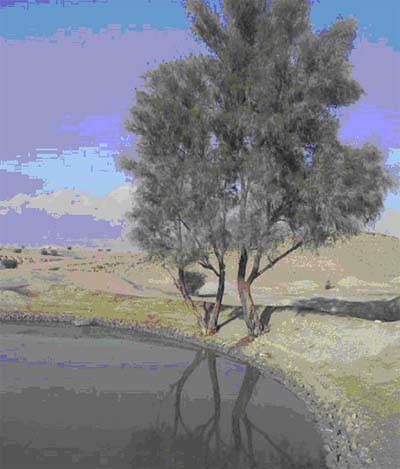
Figure 6 Traditional pool used for collecting water for herds, made by digging a pit to collect rain water (wintering grounds of the Koohi Sub-tribe)
The Qashqai and other pastoralists have also developed systems for rehabilitating rangelands and improving vegetation. For instance, they have developed a system of planting seeds of wild plants along the migration route (small bags filled with seeds were carried around the necks of sheep and goats and the seeds would spill out of small holes in the bag as the herds migrated across the mountains), assessing the number of livestock that a rangeland could carry in any given season and adjusting their numbers of livestock accordingly, discussion and agreement on the price to sell livestock, and finally leaving fallow certain areas of grazing lands that were being exhausted.
Drought is a regular occurrence for pastoralists in the province of Fars. Over the past 40 years they have become accustomed to seeing less rain in 5-6 year cycles. However, the impact, patterns and frequency of drought, as well as social responses to it, have all changed greatly over the past decades. Perhaps the most significant change is that before the weakening of pastoral organisations there was less post-drought sedentarisation whereas this has become a very regular and predictable occurrence now. Interestingly, one of the main indicators used informally by pastoralists to express the severity of a drought is the numbers of pastoralists that are forced to sedentarise as a result. There is a special term for sedentarisation among the Qashqai, eldan dushmak, which means “separating from the tribe” in Turkish.
The last severe drought that the Koohi Sub-tribe remember was roughly 50 years ago (roughly 1960-1962) when 50-60% of Qashqais were forced to settle in villages and towns. They refer to this drought as qara yil, “black year” in Turkish. Subsequent severe droughts followed by mass sedentarisation have also been referred to as qara yil.
We all waited for rain but it didn’t come. Many livestock and camels died and livelihoods were destroyed. Some people had to carry their own possessions and became known as posht-e beh kool [those who carry their possessions on their backs]. Most of these people settled in Farashband, Firoozabad and Shiraz.
Besides the changing impact of drought, patterns of drought also started changing from the mid 1980’s.
The drought of 1363 [March 1984 to March 1985] was the first drought where the wintering and summering grounds were both badly affected. Until then it was usually only one or the other. We were forced to sell the weakest and thinnest animals or send them to the cities by truck. This was the second very large wave of sedentarisation.
The duration of drought also seems to be increasing. The Sub-tribe say that the drought of 2000 is not really over since there is less water and vegetation than normal in the wintering grounds this year. They call this year - 2003 - a “semi-drought” year.
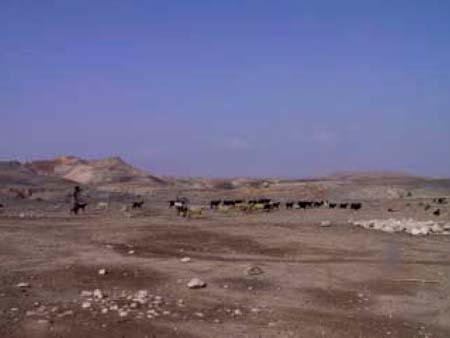
Figure 7 The winter pastures of the Koohi Sub-tribe during the “semi-drought” winter of 2002/3.
In terms of government support during a drought, the pastoralists reported little change since the first drought they mentioned, the “black year” of 1962: there has never been any significant support from the government.
Their own responses to drought, however, have changed drastically. Their use of traditional knowledge and natural resource management systems have decreased tremendously although they are still not insignificant. There is interest in reviving traditional systems of drought and range management but they feel that this would be impossible under current policies that severely limit their access to land.
In the past we used to leave some lands fallow to give them time to recover and this technique worked very well. But now it’s unthinkable because there is so little land left for us that we can’t afford to leave part of it unused.
In the past we spent about 2 months on the migration route twice each year. During this time when we were en route the summering and wintering grounds both had time to recover. We would arrive at the summering grounds just in time- when the vegetation was full and lush. Now we are forced to migrate by truck because the migration routes have been taken over [for agriculture, industrial development, urban sprawl and roads]. The migration now only takes one day so we arrive at the summering grounds very early. We’re not allowed to stay at the wintering grounds any longer according to our grazing permits and in any case there would be nothing for our animals to graze on if we did stay. Of course the rangelands become deteriorated but what can we do? The only families that continue to endure the hardships of migration on foot are those that are too poor to rent trucks.
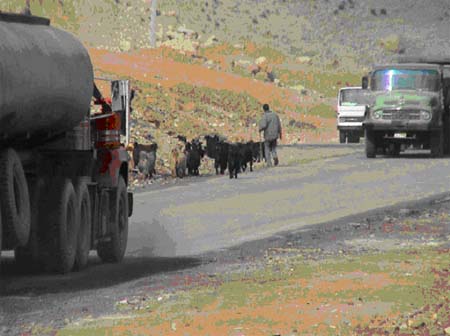
Figure 8 While cars and trucks speed by, a Koohi pastoralist and his herd migrate to their summering grounds. Many animals are lost each year in car accidents.
Furthermore, now that there are modern communications and there is no chance of making adjustments to the date and duration of the migration route, the scouts have become redundant. As a result there is a new incentive for pastoralists to migrate as soon as possible: to lay claim to their piece of land in the grazing grounds.
Another major change has been increased dependence on bought fodder. This allows pastoralists more flexibility, but it also represents a new cost. In the past- even as recently as the drought of 50 years ago- it was not common to buy fodder for the herds, nor was fodder as easily available as it is now. In the late 1960’s the more wealthy and educated members of the tribe were able to establish connections with sources of fodder for their livestock, such as waste by-products from a sugar factory. Furthermore, new breeds, which started to be introduced at about the same time tend to be less hardy and therefore more reliant on fodder. Using fodder may help pastoralists survive harsh conditions and drought, but as it becomes more common it represents an important additional cost (excerpt from above-mentioned article in Seedling magazine):
Our traditional breeds managed with whatever was available - and because the rangelands were healthier there was much more available. For example, our sheep used to go into the desert in the winter and there was plenty for them to graze on. Now we have to buy feed for them. We did that very rarely in the past - for instance, because of drought. And there are many other increased costs.
Now we have to hand-feed our herds for about 8 months of the year. They only have enough to eat from the rangelands for about 4 months per year.
These increased costs represent one of the main sources of pressure on pastoralists and factor into the greater tendency to abandon pastoralism and sedentarise following a drought. When asked why the traditional breeds had been increasingly replaced by new breeds even though they were better suited to the environment, pastoralists pointed to economic and socio-cultural factors, and sometimes to a combination of the two, including the pressures of the recent drought. These reasons show a greater dependence of pastoralists on the market than existed in the past.
Of course there are various reasons in each region for the decline of traditional breeds, but I think it basically comes down to a matter of cost. Our costs kept increasing till about 10 or 15 years ago when keeping the traditional Sangesar breed just wasn’t cost effective anymore. The new breeds are better suited to consumer demand. The Sangesar sheep are small so there’s not that much meat and they have large fat tails, but people avoid animal fat these days because they say it’s bad for you. The new breeds we have adopted are larger, with less fatty tails. The drought over the past years has made our work very unprofitable.
It [Land Reform] brought about a big change in our lives. Cooperative work within the family doesn’t exist anymore. In the past the extended family would go to yeylaagh (summer pastures) and work together. We used the milk and wool - not just the meat - because there were enough people to do that labour-intensive work. But now that we don’t have that labour force anymore our livestock are more geared towards meat production.
Nevertheless, coordination still takes place on a number of important issues relevant to drought within the sub-tribe at the level of the clan and the tenthold. For instance, members of the same clan agree on the time of their migration (although they have to work within the restrictions on timing of migration set by the government). They also collaborate on the purchase and marketing of livestock products and other goods. During the recent drought the Koohi used these traditional mechanisms:
The leaders of the clans met to discuss and agree on the best ways for using the resources of the rangelands during the drought; their main strategy was to try to leave the winter grazing area (where the drought was more severe) as soon as possible;
joint decisions were taken about buying fodder and transporting water to wintering grounds; fodder was bought in the summer pastures to prepare for drought in the winter pastures;
they tried to prolong the migration route in order to arrive at the pastures later in the dry season (only among clans that continue to migrate by foot);
there was a limited use of the nim soudi system of loans (particularly for very vulnerable families and among very close family members), but trust is an important prerequisite for the success of this system;
some members of the sub-tribe who were better off shared their fodder with those who were less well off (mostly limited to close family relatives); and,
they made some rough predictions about the weather and drought by observing the behaviour of the monajem: “If the monajem stay longer in the summer pastures then we take this as a red alert”.
Delaying and/or prolonging the time of migration and the period of use of the pastures has proved to be the least effective application of the traditional mechanisms. This is because these activities are very highly regulated by the government and there is very little flexibility for pastoralists regarding the timing of pasture use. Furthermore, since many of the migration routes have been destroyed and pastoralists increasingly rely on road transportation they are not able to prolong their migration period as in the past. The Koohi reported that in drought years they even have to resort to hand-feeding their animals on the migration routes.
|
[4] Cooperatives in Iran are
established in rural and pastoral areas by the government. The cooperatives are
governed by the law of cooperatives and the Ministry of Cooperatives and are
based on an imported Danish model. Members of the boards of cooperatives are
appointed by government. |